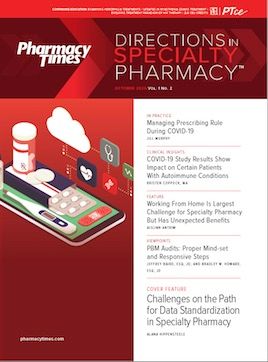Publication
Article
Specialty Pharmacy Times
Managing Prescribing Rules, Real-Time Verifications Into Workflow During COVID-19
Author(s):
Being able to cleanse and update patient information, and improve data insights can help health care professionals achieve optimal health outcomes and complete an overall shift to value-based care.
The growth of telehealth, ongoing prescriber verification challenges, and the need for a universal patient identifier (UPI) are all key issues that the coronavirus disease 2019 (COVID-19) pandemic has presented for pharmacists, according to a session at the National Association of Specialty Pharmacy 2020 Annual Meeting & Expo Virtual Experience.1
During the COVID-19 pandemic, keeping up with the myriad changes occurring on a seemingly daily basis across the health care landscape has become even more difficult, said Jill Regan, RPh, director of relationship management at LexisNexis Risk Solutions.
At the start of the pandemic, the health care community initially expressed concerns regarding the use of telehealth because of Health Insurance Portability and Accountability Act (HIPAA) privacy rules. In response, the US Department of Health & Human Services Office of Civil Rights issued a notification of enforcement discretion to empower health care providers to use widely available communications with applications. As long as the electronic medium used to deliver services is via a non—public-facing application and is HIPAA compliant, it is cleared for use; these include Microsoft Teams, Zoom for Healthcare, Amazon Chime, and GoToMeeting, Regan said.
In a US Centers for Medicare & Medicare Services memo regarding benefits, Medicare advantage organizations were allowed to provide Medicare Part B services via telehealth in any geographic area, including in beneficiaries’ homes. Further, the organizations may waive prior authorization (PA) requirements that apply to tests or services related to COVID-19. Medicare Part D sponsors must also suspend all quantity and days’ supply edits under 90 days, relax “refill too soon” edits, and permit up to a 90-day supply in a single fill, whereas P A and step therapy requirements may continue.
Other changes as a result of the pandemic include an impact on controlled substance prescribing and how states are managing remote processing and telepharmacy and extending licensure renewals.
In terms of real-time prescriber verification within operational workflow, prescriber data change every week, according to John Heller, director of pharmacy sales at LexisNexis Risk Solutions. This information led LexisNexis to create a specialty pharmacy survey to better understand the challenges of independent and specialty pharmacies.
The survey results showed that more than 20% of respondents lack the means necessary to update prescribers’ geographic data within pharmacy software. Although 60% of respondents said they verify their providers, 10% admitted to making no effort to validate any information. “[Although] the [Drug Enforcement Agency] primarily focuses their attention on chain pharmacy, specialty pharmacy can still expose themselves to unnecessary risks and potential audits from either a state or federal licensing agency,” Heller said during the session.
Heller added that the need for accurate provider verification is important, considering that 41% of pharmacists depend on inaccurate systems to verify a new provider and 50% do not update their data in real time. A realtime prescriber validation maximizes claim results while reducing payer rejects, mitigating payer recoupment, and eliminating retrospective work, according to Heller.
These challenges are the reason UPIs are critical to interoperability and successful patient engagement, according to Erin Benson, senior director of marketing planning at LexisNexis Risk Solutions. Implementing this kind of identifier into pharmacy practice can help create a golden record on each patient and eliminate duplicates. Additionally, UPIs can improve patient safety, simplify the ability to pull up the right patient’s record quickly, and decrease administrative costs. “We believe there is a need to adopt UPI[s] to achieve operational efficiency in pharmacy and improve patient safety,” Benson said.
Being able to cleanse and update patient information, along with improving data insights by understanding and helping patients overcome social determinants, can help health care professionals achieve optimal health outcomes and complete an overall shift to value-based care, according to the panel.
REFERENCE
1. Benson E, Heller J, Regan J. Managing prescribing rules due to COVID-19, implementing real time verifications into workflow, and improving interoperability. Presented at: National Association of Specialty Pharmacy 2020 Annual Meeting & Expo Virtual Experience; September 14-18, 2020.







